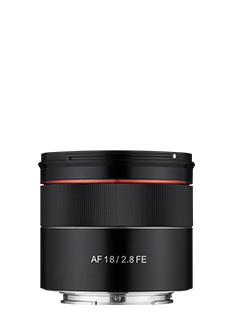PRODUCT REVIEW
AF 18mm F2.8 FE
Samyang AF 18mm f/2.8 FE Lens Review
Samyang AF 18mm f/2.8 FE Review - John Riley reviews this new FE-mount lens for full-frame and APS-C Sony E-Mount mirrorless cameras.
Samyang have a fine reputation for producing reasonably priced, excellent lenses, initially manual focus only, but for some time now with a rapidly expanding AF range. This new 18mm f/2.8 ultra-wide is a welcome addition to the range, offering a very useful focal length for Sony FE full frame mirrorless cameras. It can also be used on the APS-C format cameras, where the “35mm equivalent” field of view would be around 27mm. Here we review it using the full frame 24MP Sony Alpha A7 III. Let's see how it performs and handles and if it makes a good companion to the rest of Samyang's AF range.
Samyang AF 18mm f/2.8 FE Handling and Features
The lens is light and compact, weighing in at a svelte 145g without caps. Construction is of high quality, using appropriate plastics that reduce the weight.
There is a provided petal lens hood that bayonets securely into place and shows no sign of being likely to dislodge accidentally. The bayonet fit surrounds a standard 58mm filter thread. The front element is relatively small, not like the traditional ultra-wides that needed huge domed glass front elements. Coatings are Samyang's UMC multi-coating.
The only control on the lens is the manual focus ring. It is electronic and therefore ultra-smooth and its function is controlled via the camera menus. Sony offers various choices regarding focus – AF-S, AF-C and AF-A are the AF options and are single shooting, continuous shooting and automatic selection between the two. The MF options are DMF and MF. DMF is Direct Manual Focus and enables manual tweaks after AF has been performed. MF is of course just manual focusing. The focusing range is down to 0.25m, or 0.82 feet, which is a maximum magnification of 0.09x.
AF is driven by a linear STM motor and is precise and fast. It is also virtually silent.
Optical construction is 9 elements in 8 groups, including 3 Aspherical, 2 HR (High Refractive Index) and 3 ED (Extra Low Dispersion). The diaphragm comprises 7 blades. It is interesting that the rear element is concave rather than convex, not unheard of, but unusual. In the performance section we will see if this enhances the edge performance.
Handling is just spot on, there is nothing to the lens to cause any grief and it operates slickly and sweetly in every respect. 18mm is actually quite wide, so the biggest danger would be in not getting in close enough to subjects; to fill the foreground. Ultra-wides are lenses that cry out for dramatic compositions, as well of course enabling sweeping interior shots. For most subjects we need to get in close, and then closer still.













